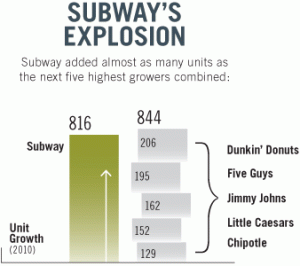Fast food franchising has been the major expansion factor for most fast food restaurants, such as McDonalds and Subway. According to A&W CEO Paul Hollands: “independent business people who have got their life savings, in most cases, tied up in the enterprise…are very committed to making that business a success.” (as cited in Korstrom), making the franchising factor an effective option for fast food companies.
Therefore, it’s questionable why certain food & drink companies choose not to franchise, such as Starbucks, which only allows a small percentage of licensees, and Chipotle (Taylor). Both companies have still been able to put up a strong presence in the fast of the industry, despite not offering franchising options. Allowing public franchising permits faster expansion, as seen in Subway’s example in Figure 1 below, and faster financial growth from the option of being in the public equity market; however, companies only receive a cut of the profit and have less direct operational control of each unit, and less corporate control, as shareholders’ input now have power. It is also harder to protect the exclusivity and quality of the brand, as there seems to be a correlation between perceived quality of product or service and presence of franchises.
Works Cited
Korstrom, Glen. “Franchisees Taking Bigger Slice Of Fast-Food Chains.” Business Vancouver.
Business in Vancouver, 2 Sept. 2014. Web. 28 Sept. 2014. <http://www.biv.com/
article/2014/9/franchisees-taking-bigger-slice-of-fast-food-chain/>.
Oches, Sam. “The 2011 QSR 50.” QSR. Journalistic Inc., n.d. Web. 28 Sept. 2014. <http://
www.qsrmagazine.com/reports/2011-qsr-50>.
Taylor, Kate. “Why Chipotle Won’t Franchise.” Entrepreneur. Entrepreneur Media, Inc., 10
Sept. 2014. Web. 28 Sept. 2014. <http://www.entrepreneur.com/article/237252>.

